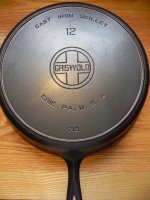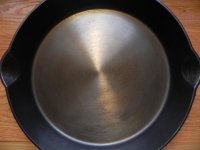Folks,
Why not this? Brass bristle brush on the end of a drill. So fast. So easy. Attach to drill. Drill-clean piece for a few minutes. Done.
Right now, I have a frying pan in an electro-bath. It takes a long time, has a big setup, and some cleanup. If it's fine to just use the brass brush on the pan, then I can't see why I'd continue with electrolysis, even though its interesting.
Tom
---------- Post added at 05:31 PM ---------- Previous post was at 05:30 PM ----------
Additional bonus: no flash-rust possible.
Why not this? Brass bristle brush on the end of a drill. So fast. So easy. Attach to drill. Drill-clean piece for a few minutes. Done.
Right now, I have a frying pan in an electro-bath. It takes a long time, has a big setup, and some cleanup. If it's fine to just use the brass brush on the pan, then I can't see why I'd continue with electrolysis, even though its interesting.
Tom
---------- Post added at 05:31 PM ---------- Previous post was at 05:30 PM ----------
Additional bonus: no flash-rust possible.


